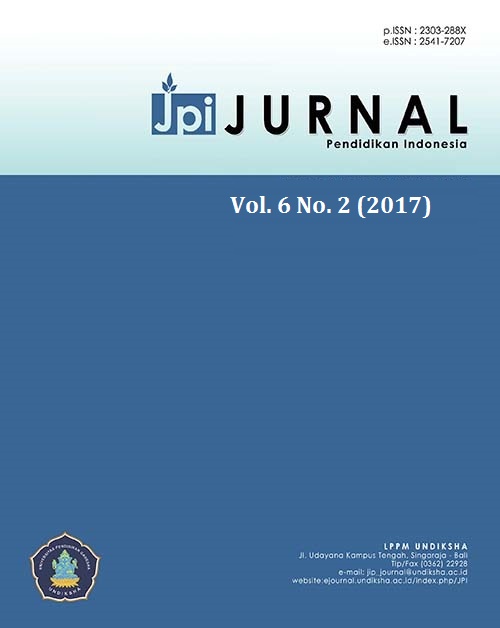Thinking Reflective Process of Student School First in Troubleshooting Reviewed From Learning Creativity
DOI:
https://doi.org/10.23887/jpi-undiksha.v6i2.9963Keywords:
Reflective thinking, Problem solving, Creativity of student learning.Abstract
The study aimed to describe the process of reflective thinking of students in solving mathematical problems in terms of the creativity of student learning high and medium categories. This type of research is qualitative. The qualitative method selected for determining the profile of reflective thinking of students in solving mathematical problems set in the natural and the main instrument is the researcher's own research. The results of the study obtained similarities and differences in students' reflective thinking processes are in high creativity and mathematical problem solving. During the preparation stage are the equation of student creativity and medium height, namely: the spirit of student responses when given KPM, after which students can express things that are known and asked is complete and correct. While the difference is high creativity Students understand the issues carefully. Differences reflective thinking processes and high creativity is about how students gather relevant information that will be used.
References
Dewey J. 1933. How We Think: A Restatement of the relation of reflective thinking to the educative process, Boston, MA: D.C., Heath and Company.
Gagatsis, A. dan Patronis, T. 1990. Using geometrical models in a process of reflective thinking in learning and teaching mathematics. Educational Studies in Mathematics Netherlands. 12, 29-54.
Ibrahim. 2011. Peningkatan Kemampuan Komunikasi, Penalaran dan Pemecahan Masalah Matematis serta Kecerdasan Emosional Melalui Pembelajaran Berbasis Masalah Pada Siswa Sekolah Menengah Atas. Disertasi pada SPS UPI. Bandung: Tidak Dipublikasikan.
Kosslyn, S., M. 2005. Reflective thinking and mental imagery: a perspective on the development of posttraumatic stress disorder. Development and Psychopathology Journal. 17, 851-863, Cambridge University Fress.
Krulik, S. dan Posamentier, A. S. 2009. Problem Solving in Mathematics, Grades 3-6: Powerful Strategies to Deepen Understanding. United States of America: Corwin.
Nindiasari, H. 2013. Meningkatkan Kemampuan dan Disposisi Berpikir Reflektif Matematis serta Kemampuan Belajar Siswa SMA melalui Pembelajaran dengan Pendekatan Metakognitif. Disertasi pada SPS UPI. Bandung: Tidak Dipublikasikan.
Odiba, I. A. Dan Baba, P. A. 2013. Using reflective thinking skills for education quality improvement in Negeria. Journal of Education and Pratice, 4(16).
Schunk, D. H. 2012. Learning theories an educational perspective sixth edition. United State of America: Pearson Education.
Skemp, R. 1982. The Psychology of Learning Mathematics. USA. Peguin Books.
Supriadi. (1989). Kreativitas dan Orang-Orang Kreatif dalam Lapangan Keilmuan. Disertasi Doktor FPS IKIP Bandung: tidak dipublikasikan.
Sezer, R. 2008. Integration of critical thinking skills into elementary school teacher education courses in mathematics. Education, 128 (3), 349-362.
Utami Munandar. 2009. Pengembangan Kreativitas ANAK BERBAKAT. Jakarta: Rineka Cipta.
Widyastuti. 2013. Proses Berpikir Siswa SMP dalam Menyelesaikan Masalah Matematika Berdasarkan Langkah-Langkah Polya Ditinjau dari Adversity Quotient. UNS: Tidak Dipublikasikan.
Downloads
Published
Issue
Section
License
Authors who publish with the Jurnal Pendidikan Indnesia agree to the following terms:
- Authors retain copyright and grant the journal the right of first publication with the work simultaneously licensed under a Creative Commons Attribution License (CC BY-SA 4.0) that allows others to share the work with an acknowledgment of the work's authorship and initial publication in this journal.
- Authors are able to enter into separate, additional contractual arrangements for the non-exclusive distribution of the journal's published version of the work (e.g., post it to an institutional repository or publish it in a book), with an acknowledgment of its initial publication in this journal.
- Authors are permitted and encouraged to post their work online (e.g., in institutional repositories or on their website) prior to and during the submission process, as it can lead to productive exchanges, as well as earlier and greater citation of published work. (See The Effect of Open Access)








